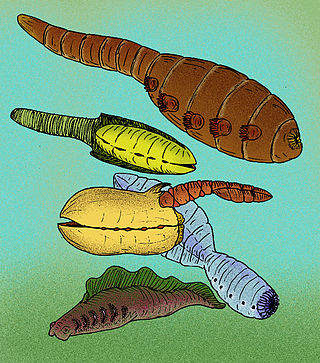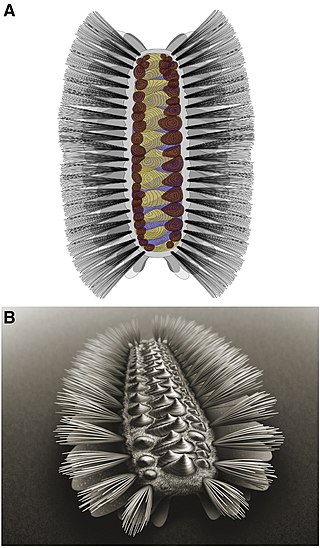
Vetulicolia is a phylum of animals encompassing several extinct species belonging to the Cambrian Period. The phylum was created by Degan Shu and his research team in 2001, and named after Vetulicola cuneata, the first species of the phylum described in 1987. The vetulicolian body comprises two parts: a voluminous anterior forebody, tipped with an anteriorly positioned mouth and lined with a row of five round to oval-shaped features on each lateral side, which have been interpreted as gills ; and a posterior section that primitively comprises seven segments and functions as a tail. All vetulicolians lack preserved appendages of any kind, having no legs, feelers or even eyes. The area where the anterior and posterior parts join is constricted.

Cycads are seed plants that typically have a stout and woody (ligneous) trunk with a crown of large, hard, stiff, evergreen and (usually) pinnate leaves. The species are dioecious, that is, individual plants of a species are either male or female. Cycads vary in size from having trunks only a few centimeters to several meters tall. They typically grow very slowly and live very long. Because of their superficial resemblance, they are sometimes mistaken for palms or ferns, but they are not closely related to either group.
Markuelia is a genus of fossil worm-like bilaterian animals allied to Ecdysozoa and known from strata of Lower Cambrian to Lower Ordovician age containing five species.

Bennettitales is an extinct order of seed plants that first appeared in the Permian period and became extinct in most areas toward the end of the Cretaceous. Bennettitales were amongst the most common seed plants of the Mesozoic, and had morphologies including shrub and cycad-like forms. The foliage of bennettitaleans is superficially nearly indistinguishable from that of cycads, but they are distinguished from cycads by their more complex flower-like reproductive organs, at least some of which were likely pollinated by insects.

Williamsonia is a genus of plant belonging to Bennettitales, an extinct order of seed plants. Within the form classification system used in paleobotany, Williamsonia is used to refer to female seed cones, which are associated with plants that also bore the male flower-like reproductive structure Weltrichia.

Conulariida are an extinct group of medusozoan cnidarians known from fossils spanning from the latest Ediacaran up until the Late Triassic. They are almost exclusively known from their hard external structures, which were pyramidal in shape and made up of numerous lamellae.

Paleontology or palaeontology is the study of prehistoric life forms on Earth through the examination of plant and animal fossils. This includes the study of body fossils, tracks (ichnites), burrows, cast-off parts, fossilised feces (coprolites), palynomorphs and chemical residues. Because humans have encountered fossils for millennia, paleontology has a long history both before and after becoming formalized as a science. This article records significant discoveries and events related to paleontology that occurred or were published in the year 2009.

Tommotiids are an extinct group of Cambrian invertebrates thought to be early lophophorates.
Tricuspisaurus is an extinct genus of reptile originally described as a trilophosaurid; it was later considered likely to be a procolophonid, but recent analyses have affirmed the original classification. Fossils are known from the Ruthin Quarry in Glamorgan, Wales, one of several Late Triassic to Early Jurassic British fissure deposits. Like some trilophosaurs, it has an edentulous, or toothless beak. Tricuspisaurus gets its name from its heterodont dentition, which includes tricuspid teeth, or teeth with three cusps. The type species, T. thomasi, was named in 1957 along with the possible trilophosaur Variodens inopinatus from Somerset, England.

Nilssonia is a genus of fossil foliage traditionally assigned to the Cycadophyta either in Cycadales or their own order Nilssoniales, though the relationships of this genus with the Cycadales have been put into question on chemical grounds.

Zamites is a genus of sterile foliage known from the Mesozoic of North America, Europe, India and Antarctica through the Eocene of North America. It was erected as a form taxon for leaves that superficially resembled the extant cycad Zamia, however it is now believed to belong to a similar but phylogenetically different group, the cyacadeoids (Bennettitales). The fronds are linear or lanceolate in shape, and pinnately compound, with pinnae with parallel veins and smooth margins, and symmetrical and constricted at the base where they are attached obliquely to the upper surface of the rachis. It has been interpreted as a Bennettitalean plant in the family Williamsoniaceae. It is associated with the ovulate cone Williamsonia and male cone Weltricihia.

Pterophyllum is an extinct form genus of leaves known from the Carnian to the Maastrichtian, belonging to the Bennettitales. It contains more than 50 species, and is mainly found in Eurasia and North America.
Araucarites is an extinct genus of conifer, used to refer to female conifer cones that resemble those of the family Araucariaceae. Species assigned to the genus lived in the Permian to Eocene and have been found worldwide.

Ptilophyllum is an extinct form genus of leaves belonging to the extinct seed plant order Bennettitales. The leaves, like other Bennettitales morphogenera are generally pinnate. Leaves possibly attributable to the genus are known from the Oligocene of Australia, which may be the last known representatives of the order.

Otozamites is an extinct form genus of leaves belonging to the Bennettitales.
Pelourdea is an extinct genus of conifer. Species belonging to the genus lived from the Triassic to the Middle Jurassic and have been found in Europe and North America.
This paleobotany list records new fossil plant taxa that were to be described during the year 2012, as well as notes other significant paleobotany discoveries and events which occurred during 2012.
Eoginkgoites is an extinct form genus of bennettitalean leaves from the Late Triassic of North America. Despite its palmate (hand-shaped) appearance similar to some early ginkgo species, it belongs to a different gymnosperm order, the Bennettitales. The leaf is deeply segmented into five to seven narrow, club-shaped lobes which twist around a very short rhachis. This leads to an overall fan-shaped leaf situated at the end of a long petiole. The leaf has paracytic stomata and veins which strongly branch and lead to a marginal vein at the edge of each leaflet. These structural traits are all shared with benettitaleans. Williamsonia carolinensis, an ovule-bearing bennettitalean cone, has been found closely associated with Eoginkgoites leaves, seemingly confirming its benettitalean identity.
Taeniopteris is an extinct form genus of Mesozoic vascular plant leaves, perhaps representing those of cycads, bennettitaleans, or marattialean ferns. The form genus is almost certainly a polyphyletic category for unfertile leaves of a certain shape ("taeniopterids") which cannot be assigned to specific groups due to a lack of information on cuticle or spore structures. The leaves are simple, with a strong central vein (rhachis) and an unbroken margin. The central vein leads to nearly perpendicular lateral veins, which may be slightly divided or undivided. The shape of the leaf is variable, but often elongated and smooth-edged. "Taeniopterid" leaves with bennettitalean-type cuticle are placed in the form genus Nilssoniopteris, while those with cycad-type cuticle are placed within Nilssonia and related genera. Some fertile "taeniopterids" preserve spore packages, and can be assigned to marattialean ferns.

Komlopteris is an extinct genus of "seed fern" with possible corystosperm affinities. Fossils have been found across both hemispheres, dating from the latest Triassic to the early Eocene (Ypresian), making it the youngest "seed fern" in the fossil record.












